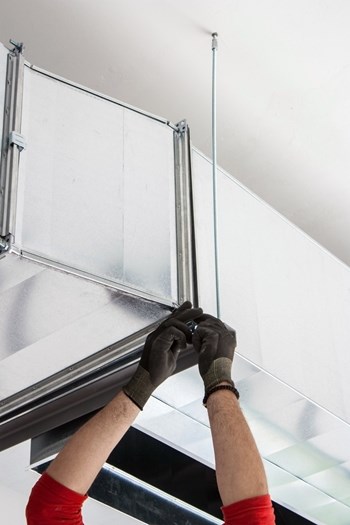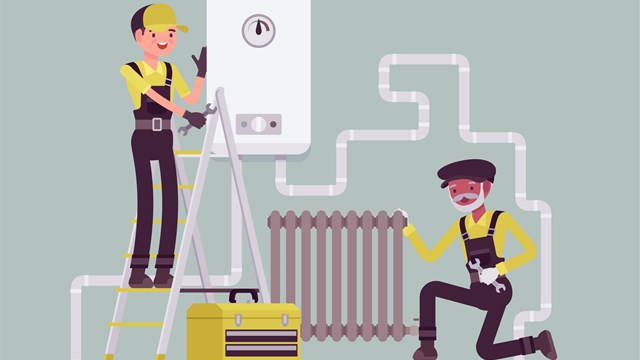
Co-op and condo boards must remain vigilant against all kinds of potential hazards in their buildings; everything from Legionnaires' disease in rooftop cooling tanks to deteriorating pointing on brick facades, to unsecured window-unit air conditioning can be a threat to both health and property.
You can add dirty air vents and ducts to the above as well. Suspect vent work includes central air-conditioning ductwork: building-wide or individual apartment units, dryer vents, and restaurant kitchen vents. The FDNY requires restaurants to have their vented exhaust systems inspected and cleaned every three months -- yet there are no such requirements for residential buildings and units.
Where My Ducts At?
The presence of ductwork pretty much depends on when your building was built. For simplicity’s sake, let’s divide New York City’s residential buildings into three groups: pre-war buildings (constructed prior to 1941); post-war buildings (built after World War II and through the early 1990s); and post-modern buildings (erected since the early 1990s).
Pre-war buildings are unlikely to have building-wide vents. Circulation systems of this type were not included -- if not unknown -- at the time of their construction. Rooms, in particular kitchens and bathrooms, had windows for air circulation. Even common hallways had windows.
After World War II, building styles and designs changed. Architects placed kitchens and bathrooms in interior positions within apartments, eliminating windows and adding ventilation ducts to promote circulation. Interior hallways became completely interior, and were also ventilated by ducts and vents. Air exchange was executed by fans on rooftops that forced circulation. For the most part, air conditioning was still window-based, with combination forced individual room-based HVAC systems entering the picture during the 1970s. Some larger properties had roof-based central air systems.
Design changes in the early 1990s resulted in buildings with units that were completely self-sufficient in terms of ductwork and ventilation. These units might contain additional ductwork and venting for in-apartment clothes dryers. Around that time as well, many pre-war buildings that had converted to co-op and condo ownership began permitting individual ducting, which became more practical with advances in technology. Also, the growth in in-building laundry rooms and other amenities requiring clean circulating air in windowless rooms has increased the commonality of such duct work and venting in all types of buildings.
What Lurks Beneath
Simply put, what is found in ducts is “dirt,” says Howard Lupowitz, the owner and founder of Air Vent Medics, a vent-cleaning business located in Brooklyn. Specifically, he explains, the particulate in ducts and vents can contain everything from dust, to dead human skin cells, to dog and cat dander. This particulate can build up over years -- and depending on whether it is a dry or moist environment, it can become the nutritional source for black mold, "which is a major cause of upper respiratory illness and allergic reactions," Lupowitz says. He should know; Lupowitz got his start in air conditioner cleaning and maintenance many years ago, and then realized, thanks to his own struggles with acute allergies, that particulate matter was a battle that he needed to fight. “Black particulate matter, what is generally found in vents and ductwork, is unhealthy,” he says. If it's present, it will also grow around the outside of the vents and appear as black spots. "If there is any mold in the space, it is usually in the air-conditioning as well,” he cautions. It contains allergens that can cause or exacerbate allergic reactions in both humans and pets. Dryer vent fires are also a major concern. “A clothes dryer is dangerous,” Lupowitz adds, “because the more lint, the bigger the potential fire.”
Treatment
Lupowitz explains that treatment of the mold requires several steps. It takes about a day in most cases, and involves three separate machines and an anti-mold treatment. The cost can range from $1,500 to $2,100, depending on the scope of the job and the space. High ceilings requiring scaffolding can cost considerably more.
The ductwork is cleaned with a Rotobrush, a machine system that scours the particulate from along the sides of the ductwork walls. Then a second cleaning is done with a Ram air system, which blasts air through the vents, hopefully dislodging any remaining bits of grime. A final cleaning is performed with the Viper Clean Sweep System, the role of which is to “scrub lodged dust and air sweep it away.” Afterward, the entire duct is treated with Mold-X, an environmentally safe chemical product that prevents -- or at least retards -- the growth of dangerous mold.
According to the pros, if correctly maintained and fitted with the proper filters, an air duct system should only need a full cleaning every two to three years.
What’s a Board to Do?
As is the case with all potential hazards, co-op and condo boards should consider the problem carefully and consult with their managing agents to determine what if any problem might exist in their air ducts. If a problem is found, the manager should contact several air vent cleaning companies, obtain bids, and get the vents cleaned before a bigger problem occurs. If your apartment contains individual ducts and vents, you should probably do the same.
Alan Sidransky is a staff writer for The Cooperator and a published novelist.






Leave a Comment